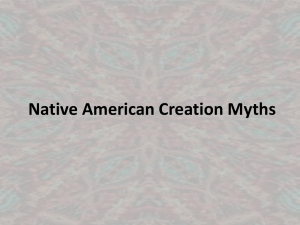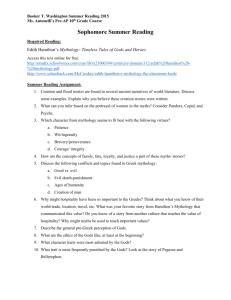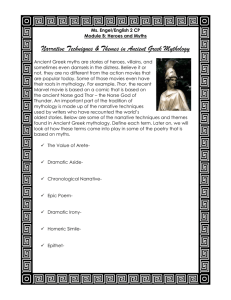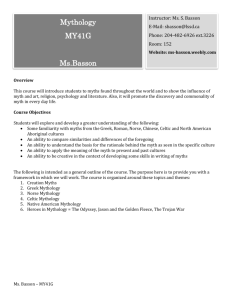Specific Learning Outcomes - College of Micronesia
advertisement
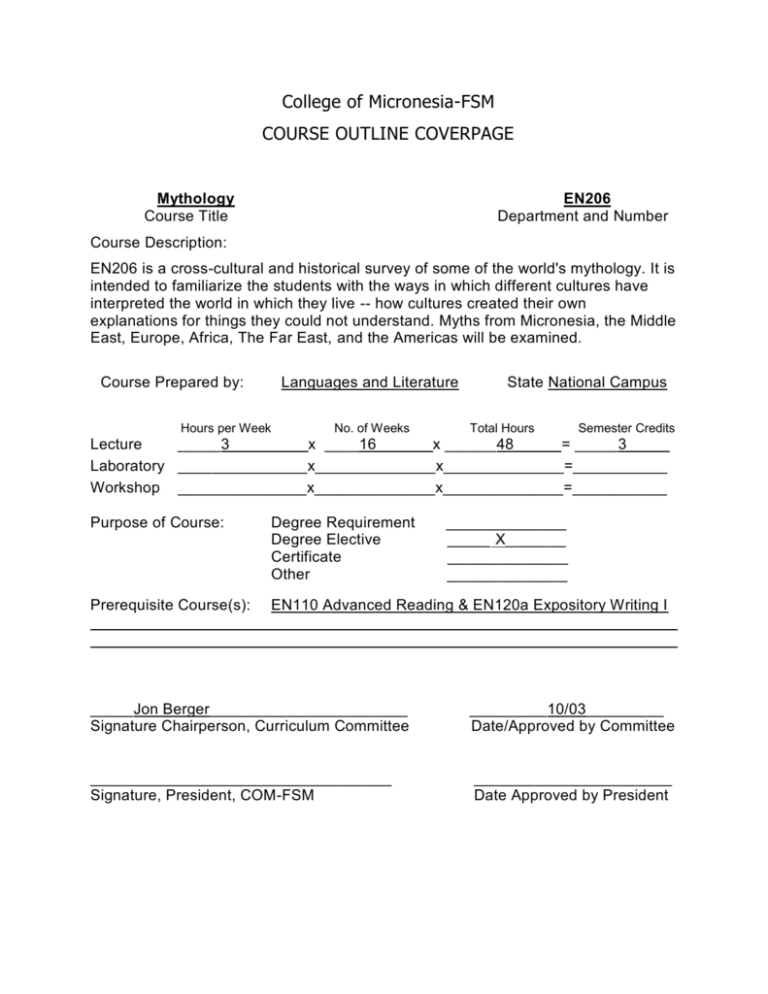
College of Micronesia-FSM COURSE OUTLINE COVERPAGE Mythology Course Title EN206 Department and Number Course Description: EN206 is a cross-cultural and historical survey of some of the world's mythology. It is intended to familiarize the students with the ways in which different cultures have interpreted the world in which they live -- how cultures created their own explanations for things they could not understand. Myths from Micronesia, the Middle East, Europe, Africa, The Far East, and the Americas will be examined. Course Prepared by: Languages and Literature Hours per Week No. of Weeks State National Campus Total Hours Semester Credits Lecture _____3______ x ____16______ x ______48_____ = _____3_____ Laboratory _______________x______________x______________=___________ Workshop _______________x______________x______________=___________ Purpose of Course: Degree Requirement Degree Elective Certificate Other Prerequisite Course(s): EN110 Advanced Reading & EN120a Expository Writing I _____Jon Berger_______________________ Signature Chairperson, Curriculum Committee ___________________________________ Signature, President, COM-FSM ______________ _____ X_______ ______________ ______________ _________10/03_________ Date/Approved by Committee _______________________ Date Approved by President EN206 Mythology (3 credits) Course Description EN206 is a cross-cultural and historical survey of some of the world's mythology. It is intended to familiarize the students with the ways in which different cultures have interpreted the world in which they live -- how cultures created their own explanations for things they could not understand. Myths from Micronesia, the Middle East, Europe, Africa, the Far East, and the Americas will be examined. General Learning Outcomes: 1. Mythological Awareness: Students will be able to discuss the ways in which the themes and patterns of myths can provide insights into human experience. 2. Cultural Awareness: Students will be able to describe the ways in which cultural circumstances and values are reflected in myths. 3. Historical Awareness: Students will be able to relate the historical background in which myths have been created. 4. Literary Awareness: Students will be able to analyze literary elements within a myth, fable or legend. 5. Critical Reasoning: Students will analyze and interpret myths through systematic reading, writing and discussion assignments about mythology. 6. Communication: Students will be able to communicate effectively their analyses, interpretations and critiques through group discussions about myths and mythology. 7. Writing: Students will be able to regularly produce compositions on specific mythological topics and issues including structured discussion guides, essay tests, and a formal research essay. 8. Research: The students will be able to conduct library and online research to support written assignments about mythology. Specific Learning Outcomes 1. Mythological Awareness: Students will be able to 1.1. identify common themes found in mythology 1.2. identify myths which exhibit a similar theme 1.3. analyze similarities and differences between myths with similar themes. 1.4. analyze the characteristics of the various individuals in a story and compare or contrast those characteristics to the student's personal or cultural attitudes and behavior . 2. Cultural Awareness: Students will be able to 2.1. identify relationships between myths and their cultural settings. 2.2. discern the specific elements with a story that reflect the values of a culture. 3. Historical Awareness: Students will be able to 3.1. identify the historical period during which the tale originated and the geographical region to which the tale belongs. 4. Literary Awareness: Students will be able 4.1. summarize the plot of the story 4.2. relate sequential events and important details in the plot. 4.3. analyze a literary elements within a myth, fable or legend in terms of theme, plot, setting, characterization, and style. 4.4. identify literary techniques (such as foreshadowing and figures of speech) that make each selection effective. 4.5. Identify implied character motivation and the relationship between the cause and effect of a character's actions. 4.6. illustrate a broadened vocabulary by utilizing vocabulary words to describe • • • aspects of a character's personality. aspects of a plot or setting. cultural concepts (such as chivalry, karma, matriarchy/patriarchy). 5. Critical Reasoning: Students will be able to 5.1. define the different criteria for myths, legends and fables. 5.2. analyze and categorize various tales by genre and justify their determinations of myths, legends, or fables. 6. Communication: Students will be able 6.1. state an opinion/argument and contribute supporting evidence relevant to the topic under discussion. 7. Writing: Students will be able 7.1. record or translate a myth, legend, or fable from the student's own culture/language into English. 7.2. employ expository writing to explicate, analyze or persuade. 8. Research: The students will be able to 8.1. research a specific topic and produce a short (3-5 pages) documented research paper on the stated topic. Course Content: Content includes a selection of myths from various historical periods and cultures around the world. The instructor will primarily select from but is not limited to the following myths listed in 2-6. 1. Introduction to Mythology 2. Micronesia a. Origins of Islands and Peoples b. Origins of Reefs, Waters and Landmarks c. Stories of Customs, Skills, and Values 3. Africa a. The Creation of Human Beings (Shilluk/Sudan) b. Anansi, the Clever One (Ashanti/Ghana) c. The Woman with One Hand (Swahili/Eastern Africa) d. The Roamer of the Plain (Baronga/Mozambique) e. The Crocodile and his Son (Fan/Equatorial West Africa) 4. The Middle East a. Enki, Lord of the Earth and Waters of Life (Sumerian/Iraq) b. Adapa (Akkadian/Iraq) c. The Craftsman's Wife (Jewish/Northern Africa) d. Rostam, Shield of Persia (Persian/Iran) e. The Tragedy of Sohrab (Persian/Iran) 5. Europe a. b. c. d. e. Prometheus, the Fire-Bringer (Ancient Greek/Greece) Oisin MacFinn, Poet of the Fianna (Celtic/Ireland) Saga of Gunnlaug Serpent-Tongue (Icelandic/Iceland) Aucassin and Nicolette (Medieval French/France) Doctor Faust (Germanic/German) 5. The Americas a. Botoque, Bringer of Fire (Kayapo/Brazil) b. The Little Frog (Spanish/Chili) c. Journey beneath the Earth (Mbundu/Haiti) d. El Bizarron and the Devil (Cuban/Cuba) e. Wiley and the Hairy Man (African America/ Southern United States) f. The Shepard who understood Animal Speech (Hispanic/Southwestern United States) g. Rip Van Winkle (EuroAmerican/Northeastern United States) h. Giant the Fire Bringer (Tsimshian/Canada) 6. The Far East a. Savitri (Ancient Indian/India and Pakistan) b. Three Flood Myths ---Kun and the Great Flood, Yu the Great, and the Great Flood (Ancient Chinese/China) c. Song of the Water Goddess (Ainu/Northern Japan) d. Taro Urashima, the Young Fisherman (Ancient Japanese/Japan) e. The Tiger's Whisker (Korean/Korea) f. Kerta's Sacrifice (Javan/Indonesia) Textbooks: Ashby, Eugene. Never and Always: Micronesian Legends, Fables and Folklore. 2nd ed. Eugene, Oregon: Rainy Day Press, 1997 (or newer version) Rosenberg, Donna. Folklore, Myths, and Legends: A World Perspective. Lincolnwood, IL: NTC Publishing Group, 1997 (or newer version). Required Course Materials None Instructional Cost None Methods of Instruction: This course may be taught in the traditional classroom or as an on-line course. Classroom: To achieve the stated objectives of the course, the instructor may use but is not limited to lecture, discussion, group discussion, presentations and/or projects, research papers, quizzes, tests, videos, computer software, and the Internet options available in the on-line version of the course. Online: To achieve the stated objectives of the course, the instructor may use but is not limited to on-line lectures, presentations, videos and research activities, asynchronous discussions and activities carried out through e-mail, listservs, discussion boards and/or facilitated groups, as well as, synchronous activities such as facilitated examinations, virtual classroom chat rooms, and teleconferencing. Evaluation The instructor will create measurement instruments that demonstrate competency in the stated objectives. These may include multiple choice, short answer, or essay examinations and assignments. They may also include presentations and research papers. Attendance Policy The COM-FSM attendance policy applies to this course when presented in the traditional classroom format. Academic Honesty Policy The COM-FSM Academic Honesty Policy applies to both versions of this course. EN206 Mythology Revised 10103



